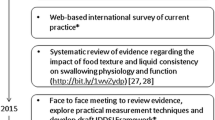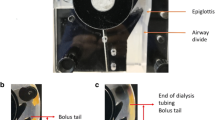Abstract
Transitional foods are under-utilized in the adult population as they may provide an opportunity to optimize eating pleasure and nutrition for individuals on a modified texture diet. Yet, little is known about the behavioral properties of transitional foods and no research to date has explored the dissolution of known transitional foods in adults. This study aimed to understand the extent of dissolution of five transitional snacks items in relationship to time, tongue pressure, and amount of saliva. Thirty individuals ages 50 to 88 participated in this study (10 with diagnosed xerostomia). The foods tested included shrimp chips, Baby Mum Mums, the EAT bar, and the Savorease cracker with and without dip. Each test food was placed in the mouth for 5 s or 12 s with or without tongue pressure and then expectorated. Benchtop preparation via the International Dysphagia Diet Standardisation Initiative (IDDSI) protocol was also completed. An IDDSI fork pressure test was then performed on all samples. Significant differences between snacks were found in degree of dissolution, with Savorease crackers dissolving more consistently than all others and Baby Mum Mums dissolving least frequently than all others. Tongue pressure positively influenced the dissolution of some foods, particularly those with decreased rates of dissolution. Differences also existed between testing conditions. Overall, there was a wide variability in degree and speed of dissolution across different transitional foods and testing methods. These findings support the need for individual testing to explore post-oral processing consistency when determining the clinical utility of transitional foods.

Similar content being viewed by others
References
Beck AM, Kjaersgaard A, Hansen T, Poulsen I. Systematic review and evidence based recommendations on texture modified foods and thickened liquids for adults (above 17 years) with oropharyngeal dysphagia—an updated clinical guideline. Clin Nutr. 2018;37(6):1980–91. https://doi.org/10.1016/j.clnu.2017.09.002.
Steele CM, Alsanei WA, Ayanikalath S, Barbon CE, Chen J, Cichero JA, Coutts K, Dantas RO, Duivestein J, Giosa L, Hanson B, Lam P, Lecko C, Leigh C, Nagy A, Namasivayam AM, Nascimento WV, Odendaal I, Smith CH, Wang H. The influence of food texture and liquid consistency modification on swallowing physiology and function: a systematic review. Dysphagia. 2015;30:2–26. https://doi.org/10.1007/s00455-014-9578-x.
Carnaby GD, Harenberg L. What is "usual care" in dysphagia rehabilitation: a survey of USA dysphagia practice patterns. Dysphagia. 2013;28(4):567–74. https://doi.org/10.1007/s00455-013-9467-8.
Ekberg O, Hamdy S, Woisard V, Wuttge-Hannig A, Ortega P. Social and psychological burden of dysphagia: its impact on diagnosis and treatment. Dysphagia. 2002;17(2):139–46. https://doi.org/10.1007/s00455-001-0113-5.
Garcia JM, Chambers E IV. Managing dysphagia through diet modifications. Am J Nurs. 2010;110(11):26–33.
Ney DM, Weiss JM, Kind AJ, Robbins J. Senescent swallowing: impact, strategies, and interventions. Nutr Clin Pract. 2009;24(3):395–413. https://doi.org/10.1177/0884533609332005.
Sura L, Madhavan A, Carnaby G, Crary MA. Dysphagia in the elderly: management and nutritional considerations. Clin Interv Aging. 2012;7:287–98. https://doi.org/10.2147/CIA.S23404.
Cichero JA, Steele C, Duivestein J, Clave P, Chen J, Kayashita J, Dantas R, Lecko C, Speyer R, Lam P, Murray J. The need for international terminology and definitions for texture-modified foods and thickened liquids used in dysphagia management: foundations of a global initiative. Curr Phys Med Rehabil Rep. 2013;1:280–91. https://doi.org/10.1007/s40141-013-0024-z.
Cichero JA, Lam P, Steele CM, Hanson B, Chen J, Dantas RO, Duivestein J, Kayashita J, Lecko C, Murray J, Pillay M, Riquelme L, Stanschus S. Development of international terminology and definitions for texture-modified foods and thickened fluids used in dysphagia management: the IDDSI framework. Dysphagia. 2017;32(2):293–314. https://doi.org/10.1007/s00455-016-9758-y.
IDDSI. IDDSI Framework Evidence Statement. 2016. https://iddsi.org/Documents/IDDSIFramework-EvidenceStatement.pdf. Accessed 5 Feb 2020.
Dovey TM, Aldridge VK, Martin CI. Measuring oral sensitivity in clinical practice: a quick and reliable behavioural method. Dysphagia. 2013;28(4):501–10. https://doi.org/10.1007/s00455-013-9460-2.
Gisel EG. Effect of food texture on the development of chewing of children between six months and two years of age. Dev Med Child Neurol. 1991;33(1):69–79.
Simione M, Loret C, Le Reverend B, Richburg B, Del Valle M, Adler M, Moser M, Green JR. Differing structural properties of foods affect the development of mandibular control and muscle coordination in infants and young children. Physiol Behav. 2018;186:62–72. https://doi.org/10.1016/j.physbeh.2018.01.009.
Awadalla N, Pham T, Milanaik R. Chew on this: not all first finger foods are created equal. Clin Pediatr (Phila). 2018;57(8):889–94.
IDDSI Complete IDDSI Framework and Detailed Definitions (2.0). 2019. https://ftp.iddsi.org/Documents/Complete_IDDSI_Framework_Final_31July2019.pdf. Accessed 5 Feb 2020.
Dawes C. Physiological factors affecting salivary flow rate, oral sugar clearance, and the sensation of dry mouth in man. J Dent Res. 1987;62(2 suppl):648–53.
Soares TJ, Moraes DP, Medeiros GCd, Sassi FC, Zilberstein B, Andrade CRFd. Oral transit time: a critical review of the literature. ABCD Arquivos Brasileiros de Cirurgia Digestiva (São Paulo). 2015;28(2):144–7. https://doi.org/10.1590/s0102-67202015000200015.
Rogus-Pulia NM, Gangnon R, Kind A, Connor NP, Asthana S. A pilot study of perceived mouth dryness, perceived swallowing effort, and saliva substitute effects in healthy adults across the age range. Dysphagia. 2018;33(2):200–5. https://doi.org/10.1007/s00455-017-9846-7.
Pajukoski H, Meurman JH, Halonen P, Sulkava R. Prevalence of subjective dry mouth and burning mouth in hospitalized elderly patients and outpatients in relation to saliva, medication, and systemic diseases. Oral Surg Oral Med Oral Pathol Oral Radiol Endodontol. 2001;92(6):641–9. https://doi.org/10.1067/moe.2001.118478.
Kaae JK, Spejlborg ML, Spork U, Bjorndal K, Eriksen JG. Reducing late dysphagia for head and neck cancer survivors with oral gel: a feasibility study. Dysphagia. 2019. https://doi.org/10.1007/s00455-019-10018-9.
Baudelet M, Van den Steen L, Tomassen P, Bonte K, Deron P, Huvenne W, Rottey S, De Neve W, Sundahl N, Van Nuffelen G, Duprez F. Very late xerostomia, dysphagia, and neck fibrosis after head and neck radiotherapy. Head Neck. 2019;41(10):3594–603.
Cui T, Ward MC, Joshi NP, Woody NM, Murray EJ, Potter J, Dorfmeyer AA, Greskovich JF Jr, Koyfman SA, Xia P. Correlation between plan quality improvements and reduced acute dysphagia and xerostomia in the definitive treatment of oropharyngeal squamous cell carcinoma. Head Neck. 2019;41(4):1096–103. https://doi.org/10.1002/hed.25594.
Smidt D, Torpet LA, Nauntofte B, Heegaard KM, Pedersen AM. Associations between labial and whole salivary flow rates, systemic diseases and medications in a sample of older people. Community Dent Oral Epidemiol. 2010;38(5):422–35.
Thomson WM. (2005) Issues in the epidemiological investigation of dry mouth. Gerondontology. 2005;22(2):65–766.
Iorgulescu G. Saliva between normal and pathological: Important factors in determining systemic and oral health. J Med Life. 2009;2(3):303–7.
Hoseini A, Mirzapour A, Bijani A, Shirzad A. Salivary flow rate and xerostomia in patients with type I and II diabetes mellitus. Electron Physician. 2017;9(9):5244–9. https://doi.org/10.19082/5244.
Hopcraft MS, Tan C. Xerostomia: an update for clinicians. Aust Dent J. 2010;55(3):238–44.
Sreebny LM, Valdini A. Xerostomia. Part I: Relationship to other oral symptoms and salivary gland hypofunction. Oral Surg Oral Med Oral Pathol. 1988;66(4):451–8.
Hiiemae KM, Palmer JB. Tongue movements in feeding and speech. Crit Rev Oral Biol Med. 2003;14(6):413–29.
Tenuta LMA, Fernández CE, Brandão ACS, Cury JA. Titratable acidity of beverages influences salivary pH recovery. Braz Oral Res. 2015;29(1):1–6.
SAS Institute. SAS/STAT 14.2 user’s guide. Cary, NC: SAS Institute, Inc. 2016. Retrieved from the SAS Product Documentation website: https://support.sas.com/documentation/index.html.
Kubala E, Strzelecka P, Grzegocka M, Lietz-Kijak D, Gronwald H, Skomro P, Kijak E. A review of selected studies that determine the physical and chemical properties of saliva in the field of dental treatment. Biomed Res Int. 2018;2018:6572381. https://doi.org/10.1155/2018/6572381.
Jeltema M, Beckley J, Vahalik J. Model for understanding consumer textural food choice. Food Sci Nutr. 2015;3(3):202–12. https://doi.org/10.1002/fsn3.205.
Delwiche J. The impact of perceptual interactions on perceived flavor. Food Qual Prefer. 2004;15(2):137–46. https://doi.org/10.1016/s0950-3293(03)00041-7.
Kohyama K. Oral Sensing of food properties. J Texture Stud. 2015;46(3):138–51. https://doi.org/10.1111/jtxs.12099.
Keller HH, Duizer LM. What do consumers think of pureed food? Making the most of the indistinguishable food. J Nutr Gerontol Geriatr. 2014;33(3):139–59. https://doi.org/10.1080/21551197.2014.927302.
Ullrich S, Crichton J. Older people with dysphgia: transitioning to texture-modified food. Br J Nurs. 2015;24(13):686–92.
Dahl WJ, Whiting SJ, Tyler RT. Protein content of pureed diets: implications for planning. Can J Dietetic Pract Res. 2007;68(2):99–102.
Nowson C, Sherwin AJ, McPhee JG, Wark JD, Flicker L. Energy, protein, calcium, vitamin D and fibre intakes from meals in residential care establishments in Australia. Asia Pac J Clin Nutr. 2003;12(2):172–7.
Vucea V, Keller HH, Morrison JM, Duizer LM, Duncan AM, Carrier N, Lengyel CO, Slaughter SE, Steele CM. Modified texture food use is associated with malnutrition in long term care: an analysis of making the most of mealtimes (M3) project. J Nutr Health Aging. 2018;22(8):916–22.
Wright L. Comparison of energy and protein intakes of older people consuming a texture modified diet. J Hum Nutr Dietetics. 2005;18(3):213–9.
Krok-Schoen JL, Jonnalagadda SS, Luo M, Kelly OJ, Taylor CA. Nutrient intakes from meals and snacks differ with age in middle-aged and older Americans. Nutrients. 2019. https://doi.org/10.3390/nu11061301.
Vatanparast H, Islam N, Patil RP, Shafiee M, Smith J, Whiting S. Snack consumption patterns among Canadians. Nutrients. 2019. https://doi.org/10.3390/nu11051152.
Weijenberg RA, Scherder EJ, Lobbezoo F. Mastication for the mind–the relationship between mastication and cognition in ageing and dementia. Neurosci Biobehav Rev. 2011;35(3):483–97. https://doi.org/10.1016/j.neubiorev.2010.06.002.
Dawes C. Circadian rhythms in human salivary flow rate and composition. J Physiol. 1972;220(3):529–45.
Damián JP, Bengoa L, Pessina P, Martínez S, Fumagalli F. Serial collection method of dog saliva: effects of different chemical stimulants on behaviour, volume and saliva composition. Open Vet J. 2018;8(3):229–35.
Pushpass RG, Daly B, Kelly C, Proctor G, Carpenter GH. altered salivary flow, protein composition, and rheology following taste and TRP stimulation in older adults. Front Physiol. 2019;10:652.
Acknowledgements
We would like to thank Dr. Donna Neusch for helping with the recruitment process and providing valuable assistance during the data collection portion of the study.
Funding
This study was not funded.
Author information
Authors and Affiliations
Corresponding author
Ethics declarations
Conflict of interest
Taste for Life, LLC, is owned by Dr. Reva Barewal. Taste for life, LLC, is a mission-based company focused on research, innovation, and education in dysphagia food products, and has created a transitional cracker line and puree dip line which were used as test samples in the current study.
Additional information
Publisher's Note
Springer Nature remains neutral with regard to jurisdictional claims in published maps and institutional affiliations.
Work for this study was performed at Oregon State University, Food Innovation Center.
Rights and permissions
About this article
Cite this article
Barewal, R., Shune, S., Ball, J. et al. A Comparison of Behavior of Transitional-State Foods Under Varying Oral Conditions. Dysphagia 36, 316–324 (2021). https://doi.org/10.1007/s00455-020-10135-w
Received:
Accepted:
Published:
Issue Date:
DOI: https://doi.org/10.1007/s00455-020-10135-w




